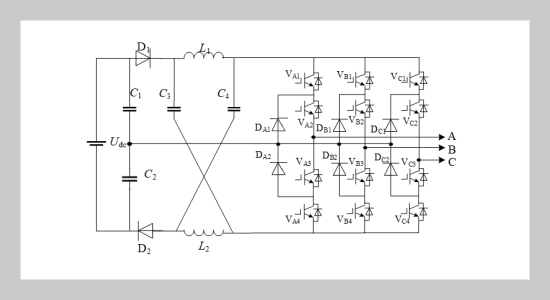REFERENCES
- [1] X. Zhang and R.X. Cao. Solar photovoltaic grid power generation and its control inverter. China Machine Press, Beijing, China, 2011.
- [2] P.Q. Li, X.J. Zeng, and J.Y. Huang. Equivalent Modeling of Grid-connected Photovoltaic Power Generation Systems for Comprehensive Load. Automation of Electric Power Systems, 40(8):43–50, 2016.
- [3] Z GAO and X JIN. Research on a back-to-back cascaded H-bridge four-quadrant five-level converter. High Voltage Engineering, 42(1):79–84, 2016.
- [4] Z.P. Luo, Y.H. Liu, and B.F. Yang. New Topology of Multi-level Converter with High- power Forced Commutation Current Injection. High Voltage Engineering, 41(7):2445–2450, 2015.
- [5] N Kalaiarasi, Subhranshu Sekhar Dash, S Paramasivam, and C Bharatiraja. Investigation on ANFIS aided MPPT technique for PV fed ZSI topologies in standalone applications. Journal of Applied Science and Engineering (Taiwan), 24(2):261–269, 2021.
- [6] Yam P. Siwakoti, Fang Zheng Peng, Frede Blaabjerg, Poh Chiang Loh, and Graham E. Town. Impedancesource networks for electric power conversion Part I: A topological review. IEEE Transactions on Power Electronics, 30(2):699–716, 2015.
- [7] F.Z. Peng. Z-source inverter. IEEE Transactions on Industry Applications, 39(2):504–510, 2003.
- [8] Biao Zhao, Qingguang Yu, Zhiwei Leng, and Xiyou Chen. Switched Z-source isolated bidirectional dc-dc converter and its phase-shifting shoot-through bivariate coordinated control strategy. IEEE Transactions on Industrial Electronics, 59(12):4657–4670, 2012.
- [9] K. Deng, J. Mei, and J.Y. Zheng. Improved SwitchedInductor Quasi-Z Source Inverter. Power System Technology, 37(11):3254–3261, 2013.
- [10] Y. Li, F. Fang, and X.Y. Xiao. Grid-connected Photovoltaic Control Strategy Based on Input-output Linearization for Quasi-Z-source Inverter. High Voltage Engineering, 45(7):2167–2176, 2019.
- [11] Haitham Abu-Rub, Atif Iqbal, Sk Moin Ahmed, Fang Z. Peng, Yuan Li, and Ge Baoming. Quasi-Zsource inverter-based photovoltaic generation system with maximum power tracking control using ANFIS. IEEE Transactions on Sustainable Energy, 4(1):11–20, 2013.
- [12] Yu Tang, Shaojun Xie, Chaohua Zhang, and Zegang Xu. Improved Z-source inverter with reduced Z-source capacitor voltage stress and soft-start capability. IEEE Transactions on Power Electronics, 24(2):409–415, 2009.
- [13] R.X. Wang, Y.X. Wu, and H.H. Yang. Research on key technologies of double-stage T-type three-level photovoltaic inverter. Power System Protection and Control, 43(4):58–62, 2015.
- [14] F Gao, PC Loh, and F Blaabjerg. Dual Z-source inverter with three-level reduced common-mode switching. IEEE Transactions On Industry Applications, 43(6):1597–1608, 2007.
- [15] PC Loh, F Gao, and F Blaabjerg. Topological and modulation design of three-level Z-source inverters. IEEE Transactions on Power Electronics, 23(5):2268–2277, 2008.
- [16] Qi Ming Cheng, Lei Shen, Yin Man Cheng, Lin Wei, and Yu Jiao Wang. Analysis and characteristics of new quasi-Z source three-level inverter. Dianji yu Kongzhi Xuebao/Electric Machines and Control, 24(9):134– 144, 2020.
- [17] Madasamy Periyanayagam, V. Suresh Kumar, Bharatiraja Chokkalingam, Sanjeevikumar Padmanaban, Lucian Mihet-Popa, and Yusuff Adedayo. A modified high voltage gain quasi-impedance source coupled inductor multilevel inverter for photovoltaic application. Energies, 13(4), 2020.
- [18] MS Kamalesh, Nattuthurai Senthilnathan, and Chokkalingam Bharatiraja. Design of a Novel Boomerang Trajectory for Sliding Mode Controller. International Journal of Control, Automation and Systems, 18(11):2917–2928, 2020.
- [19] Q.M. Cheng, S.Y. Chu, and Y.M. Cheng. Quasi-PR Control System of Grid-connected Z-source Three-level Inverter. High Voltage Engineering, 42(10):3075–3082, 2016.
- [20] X.Q. Guo. Generalized Proportional Complex Integral Control Scheme for PV Grid-connected Inverters. Proceedings of the CSEE, 35(13):3393–3399, 2015.
- [21] H. Yang, G.J. Song, and Teng F.Y. Adaptive Proportional Complex Integral Control Strategy for Singlephase Grid-connected Inverter. High Voltage Engineering, 46(11):3790–3799, 2020.
- [22] Qi Ming Cheng, Lei Shen, Yin Man Cheng, Lin Wei, and Yu Jiao Wang. Analysis and characteristics of new quasi-Z source three-level inverter. Dianji yu Kongzhi Xuebao/Electric Machines and Control, 24(9):134– 144, 2020.
- [23] W. Liu, Y. Yang, T. Kerekes, and F. Blaabjerg. Generalized Space Vector Modulation for Ripple Current Reduction in Quasi-Z-Source Inverters. IEEE Transactions on Power Electronics, 36(2):1730–1741, 2021.
- [24] Q.M. Cheng, M.Z. Zhao, and L. Shen. Modeling Analysis of Improved Quasi-Z Source Three-Level Inverter. High Voltage Engineering, 12(15):1–10, 2020.
- [25] Z.H. Wang, Z.C. Li, and H.N. Wang. MPPT study of solar PV power system based on RBF neural network algorithm. Power System Protection and Control, 48(6):85– 91, 2020.
- [26] Y. Shen, A. Luo, and Y.D. Chen. A Power FeedforwardBased Control Approach for Grid-Connection of Photovoltaic Generation and Its Stability Analysis. Power System Technology, 38(9):2449–2454, 2014.
- [27] Q.P. Dai, L. Ma, and Y. Xi. Improved Bacterial Foraging Algorithm for Continuous Optimization Problem. Journal of University of Shanghai for Science and Technology, 35(2):103–106, 2013.
















